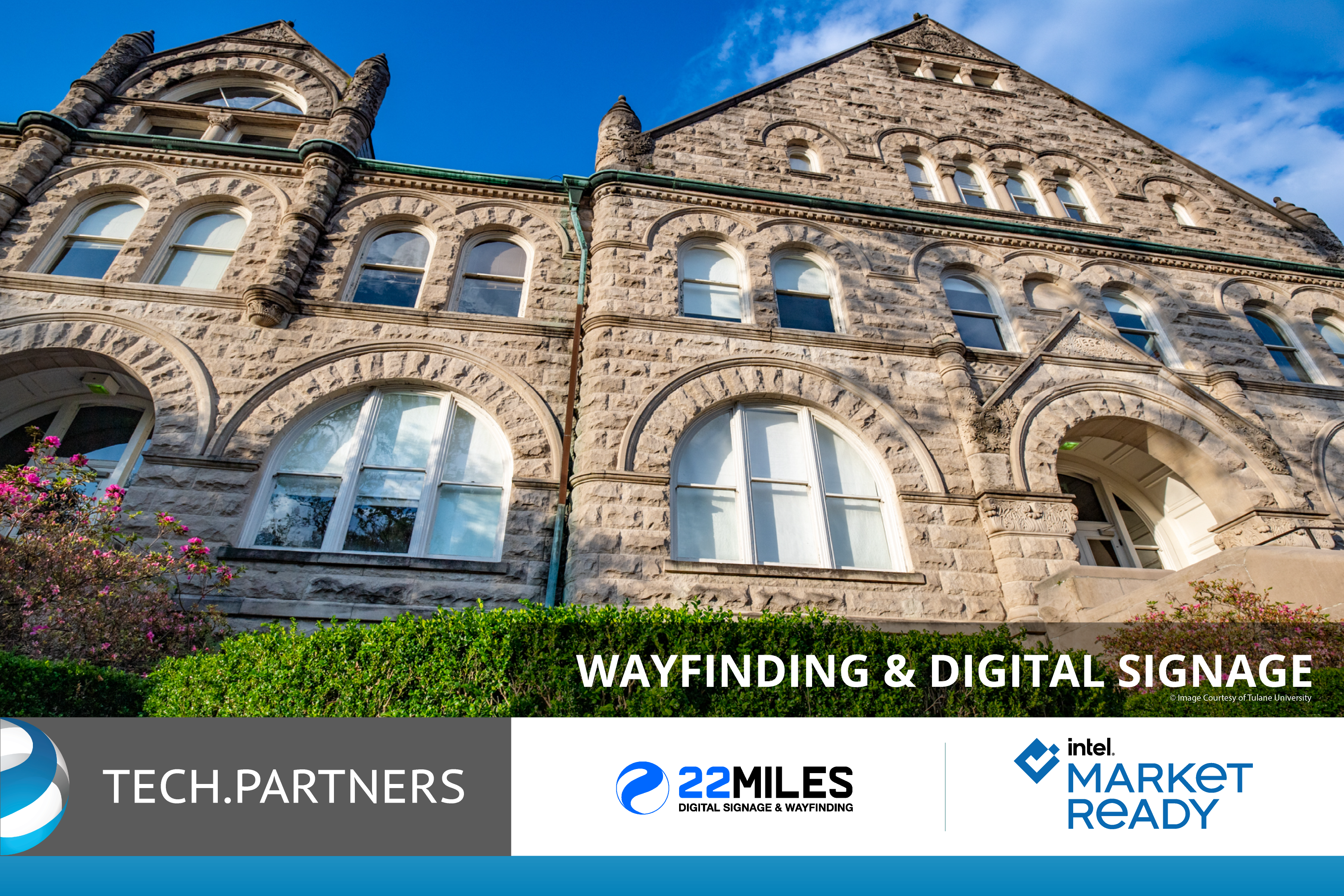Enhancing built environments with bold finishes is important, but it shouldn’t end there.
Digital signage design has the power to transform spaces into engaging and interactive experiences, using multimedia content such as videos, images, and animations to bring buildings to life and showcase their unique features. When designing next-level environments, incorporating audiovisual technology that listens, learns, and enhances the way people experience the building is crucial. In this blog, we’ll highlight how architectural designs can benefit from adopting digital signage.
What is Architectural Digital Signage?
Architectural digital signage is a sophisticated electronic system that captivates audiences through targeted messaging, encompassing various mediums like text, graphics, videos, and even atmospheric installations like art pillars or custom screens. Rather than install digital signage after the building construction is complete, architectural digital signage incorporates display technology during the design phase.
Digital signage systems incorporate a computer component or player that decodes and displays the content on the screens. This digital signage is primarily indoors within commercial, industrial, or public spaces, often specific to buildings, facilities, or campuses. However, it can also enhance outdoor areas where people gather. With digital environments surrounding us in everyday life, architectural digital signage design has become vital in commercial spaces, creating an expectation for its presence.
The development of these signage designs requires both scientific and artistic considerations. When executed effectively, architectural digital signage systems can transform spaces within a building, leaving a lasting impression and providing visitors with an immersive experience rather than a mere passage.
Signage Partners and Timing for Design
Larger AEC firms with extensive teams dedicated to experience design handle the process of integrating AV systems that align with the building’s design goals. However, partnering with a digital signage integrator is highly advantageous for most architectural firms. This collaboration brings in experts with extensive experience and knowledge, adding value to the project. It is crucial to involve the digital signage partner early in the design process, preferably during the schematic design (SD) and design development (DD) phases.
By doing so, the experience of system design becomes an integral part of the overall building design, avoiding the perception of an afterthought. When signage schema is not considered during the early design phases, the installed system suffers, appearing as an out-of-place giant rectangle sore thumb in the lobby.
Contrarily, carefully designed displays that seamlessly blend with the surrounding architecture enhance the overall ambiance of the space, providing visitors with a modern and dynamic atmosphere. As early as possible, initiating discussions among all stakeholders about digital signage design is key to ensuring the system’s success.
Signage, Content, and Architecture
The integration of digital signage design into the planning of a space is guided by various top-level system goals such as accessibility, aesthetics, function, security, or sustainability. Regardless of these goals, the primary driver of the system will always be the content it displays. A digital signage partner understands the importance of prioritizing content discussions in decision-making, recognizing that even the most beautiful content can fall short if presented on a different display or at the wrong scale.
These experts translate the methodology of AV systems and consider crucial spatial factors when designing spaces for people. For instance, they provide guidance on screen sizes for smaller, intimate areas like private meeting room entrances.
Additionally, they ask important questions to ensure the desired outcomes are achieved, such as the purpose of a display, the content to be shown, and the intended functionality. The result will be visually appealing and effective by prioritizing the content solution and considering the desired experience from the beginning.
Ultimately, the goal of signage design is to leave a lasting impression on visitors, whether it’s through purchasing, experiencing surprise and delight, or acquiring new knowledge. Research demonstrates that people retain 65% of visually presented information even after three days, making the power of a memorable experience invaluable.
Word-of-mouth recommendations driven by remarkable experiences can significantly impact the perception and reputation of a building or organization.
Selecting The Right Tech
Digital signage technology is inherently dynamic, with its components taking on various forms and serving different purposes within the system. Selecting the correct elements for each space is a crucial top-level goal in digital signage system design to ensure optimal functionality and cost-effectiveness. By partnering with a reputable provider like 22Miles, potential technology issues can be identified and addressed early in the design process, avoiding costly mistakes. Value engineering (VE) is critical to the architectural design process, driving innovation and refining design concepts.
For instance, instead of a single monolithic video wall, breaking it into smaller sections can save costs while still creating an impactful presence. Each individual screen can display content that complements the larger canvas, enhancing the audience’s experience. This video wall solution also allows for touchscreen integration, enabling interactive engagement with the screens. VE can deliver the same level of impact as the original design while offering additional opportunities for interactive content and cost savings.
Furthermore, the cost of installing digital signage has decreased over time as technology advances, making it more accessible. Between 2004 and 2010, the cost of deploying and maintaining an extensive digital signage network for three years decreased by 50%, showcasing the cost-efficiency of modern digital signage solutions.
In conclusion, digital signage design plays a crucial role in enhancing built environments by providing interactive and engaging experiences for visitors. It captures attention with dynamic multimedia content and reaches millions of people each week. The growing adoption of digital signage solutions highlights its importance in commercial spaces.
By partnering with a digital signage integrator and involving them early in the design process, architects can ensure that the system design aligns with their goals and seamlessly integrates with the overall building design. Selecting the right technology components and value engineering considerations can optimize functionality, save costs, and create impactful experiences.
By prioritizing content, considering the audience, and leveraging advancements in technology, architectural digital signage can transform spaces, leave a lasting impression, and elevate the overall ambiance of a building.



